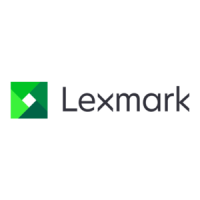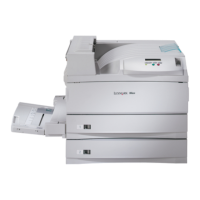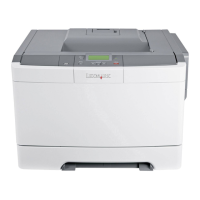Two-dimensional bar codes
28
Bar code descriptor for QR
Functional parameters for QR (HP compatibility mode)
Bar code descriptor for MaxiCode data
The data sent when using this technique for printing MaxiCode symbols will follow the same rules
that exist for data sent using the Lexmark Transfer Bar Code Data command to print MaxiCode
symbols, with the following change to rule 1:
The input data must start with a label-number field, a number-of-labels field, and a mode field. All
three of these fields are one digit in length and are terminated with either a comma or Group
Separator (GS, ASCII 29).
In relation to the fields of the Lexmark bar code descriptor for MaxiCode, the following
correspondences exist when using this technique:
Mode: Specified in the data
The Typeface (
Esc
(s#T) value for MaxiCode is 24800.
Aspect Ratio X: Specified by #s1 parameter
Aspect Ratio Y: Specified by #s2 parameter
ECC By Percentage: Fixed at 0
Typeface
Esc
(s#T Default
24860T Model 1
24861T Model 2
P parameter
Esc
(s#P
0 Optional; determines ECC level as follows:
• 0 = Default ECC level (error correction level M of 15%)
• 1 = Low ECC/High Density level (L), 7% damage allowed.
• 2 = Standard ECC level (M), 15% damage allowed.
• 3 = High reliability/ECC level (Q), 25% damage allowed.
• 4 = Ultra High reliability/ECC level (H), 30% damage allowed.
B parameter
Esc
(s#B
10 Optional; module height (and width) in dots (1/600 inch); minimum
is 1
S parameter
Esc
(s#S
0 Optional; determines encoding mode as follows:
• 0 = Use default (Automatic: JIS/ShiftJIS)
• 1 = Numeric (0-9)
• 2 = Alphanumeric (0-9; uppercase A-Z; space; and the
symbols $, %, *, +, -, ., /, and :)
• 3 = JIS 8-bit character set
• 4 = Kanji character set (shifted JIS)

